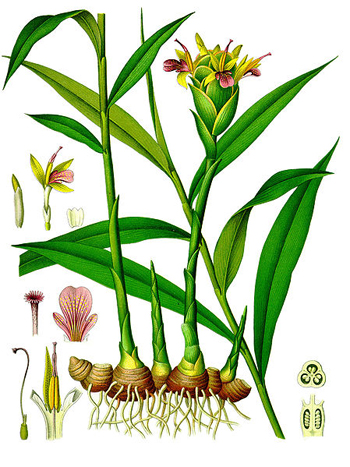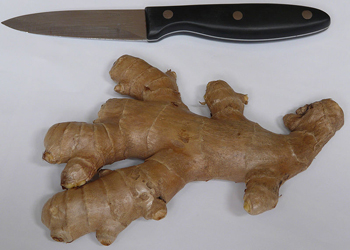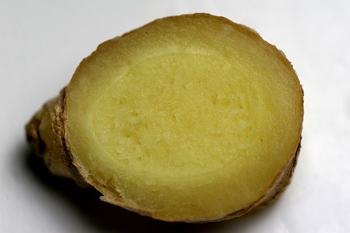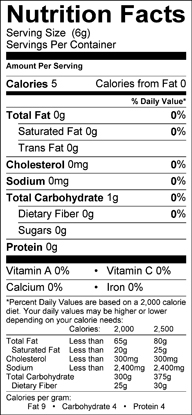Contents:
Common Names | Parts Usually Used | Plant(s) & Culture | Where Found | Medicinal Properties | Biochemical Information
Legends, Myths and Stories | Uses | Formulas or Dosages | Nutrient Content | How Sold | Warning | Resource Links | Bibliography
Scientific Names

Ginger Plant |
- Zingiber officinale L.
- Zingiberaceae
- Ginger family
Common Names
- African ginger
- Ardraka, fresh (Sanskrit name)
- Black ginger
- Chiang
- Gan-jiang, dry (Chinese name)
- Nagara, dry (Sanskrit name)
- Race ginger
- Shen-jiang, fresh (Chinese name)
- Sunthi (Sanskrit name)
Parts Usually Used
Roots and rhizomes
Back to Top
Description of Plant(s) and Culture
Ginger is a perennial plant; the aromatic, knotty rootstock is thick, fibrous, and whitish or buff-colored. It produces a simple, leafy stem covered with the leaf sheaths of the lanceolate-oblong to linear leaves. The plant reaches a height of 3-4 feet, the leaves growing 6-12 inches long. The sterile flowers are white with purple streaks and grow in spikes.
Back to Top
Where Found
Indigenous to tropical Asia and cultivated in other tropical areas, especially Jamaica.
Back to Top
Medicinal Properties
Antispasmodic, antiviral, antiemetic, analgesic, antiseptic, appetizer, aromatic, carminative, condiment, diaphoretic, expectorant, febrifuge, pungent, sialagogue, stimulant
Topically: increases blood flow to an area
Back to Top
Biochemical Information
Bisabolene, borneal, borneol, camphene, choline, cineole, citral, ginerol, inositol, volatile oils, PABA, phellandrene, phenols, alkaloids, mucilage, acrid resin, sequiterpene, vitamins B3, B5, zingerone, and zingiberene.
Back to Top
Legends, Myths and Stories

Ginger Root |
Ginger is an ancient herb native to Asia. It is produced commercially in Jamaica, Africa, Japan, China, India, and the Dutch East Indies; the best is reputed to be that of Jamaica. The Chinese have been using ginger for more than 2,000 years. The Japanese serve ginger slices between sushi courses to clear the palate and aid digestion.
In China, the poorer classes test food by tossing a slice of fresh ginger into their cooking pot. They claim that if the root turns a dark color the food is bad.
Marco Polo mentions ginger in his unbelievable narrative of the 13th century. The Spaniards brought the first ginger plants to the New World in the early part of the 16th century. The finest roots today come from Jamaica.
If ginger is grown in greenhouses, it may bloom and produce an exotic and interesting flower that looks somewhat like a miniature pineapple.
Ginger root adds an agreeable zest to many beverages. The root is used in wines, liqueurs and soft drinks.
Dry ginger is a better stimulant and expectorant; fresh ginger is a better diaphoretic, better for colds, cough, and vomiting.
The following is a quote from the book “Old Ways Rediscovered” by Clarence Meyer.”Recipe for ginger beer from The Illustrated London Cookery book (1852): Pour 2 gallons of boiling water on 1/4 lb. of cream of tartar, 1 oz. of sliced ginger, 2 lbs. of sugar; let it stand 6 hours, then add 2 tbsp. of yeast, let it stand 6 hours more, strain through fine strainer, put it into stone bottles, tie down the corks, and it will be fit for use in 24 hours.”
Another old-time favorite was the ginger tissane: made by steeping 1/2 tsp. root in 1 cup boiling water, keep saucer over the cup while steeping. Strain when only warm and sip as needed. If desired, sweeten with honey.
Natives of the West Indies add a dash of nutmeg or 1-2 cloves to the tissane.
Back to Top
Uses

Ginger Root Cross-Section |
A spicy herb used for colitis, diverticulosis, nausea, gas, indigestion, paralysis of the tongue, morning sickness, travel sickness or motion sickness, vomiting, hot flashes and menstrual cramps. Cleanses the colon, gas and fermentation, cholera, gout, nausea, arthritis, stimulates circulation, and reduces spasms and cramps.
Ginger tea or tincture, taken hot, promotes cleansing of the system through perspiration and is also said to be useful for suppressed menstruation. Take it to clear up flatulent colic or combine it with laxative herbs to make them more palatable or milder in action. Try it at the onset of a cold, flu, headaches, chronic bronchitis, to ease the effects of the usual symptoms. Finally, to stimulate the flow of saliva and to soothe a sore throat, chew the rootstock as it is. Promotes sweat when taken hot. Ginger ale is a long time remedy for upset stomach and nausea. An old-fashioned remedy for dandruff is to combine ginger with olive oil. (Applied to the scalp after shampoo) A few drops in the ears, of this oil, will soothe earaches. Ginger root is used in the treatment of minor burns and skin inflammations.
Grated ginger can be topically applied externally, as a poultice or hot fomentation to relieve painful aches, sprains, and spasms.
Some researchers think that ginger may help prevent strokes, heart disease, and hardening of the arteries. Also, a hematology researcher says it is believed that gingerol, a substance in ginger, inhibits an enzyme that causes cells to clot. The same enzyme is blocked by aspirin, effective in preventing recurrence of “little strokes”. These attacks are triggered by microscopic artery clots, flowing through the blood stream until they block arteries in the brain, causing the stroke or cerebrovascular accident, known as CVA.
The Chinese Materia Medica lists the uses of ginger for dyspepsia, diarrhea, piles, loss of appetite, nausea, vomiting, and alcoholic gastritis. If the root is chewed and the juice swallowed, it causes saliva to flow and digestive juices to be stimulated. This will also relieve nausea and vomiting. A tea made of the root improves digestion, relieves gas and bloating, and stimulates appetite.
Relief from these conditions: use 1/2 oz. of powdered ginger root stirred into 1 pint of boiling water. 2 to 3 tbsp. of the tea should be taken 3 times a day. Capsules of ginger will relieve motion sickness. Prompt relief from the morning-after “hangover” is obtained by sipping 1 or 2 cups of hot ginger tea for breakfast.
Back to Top
Formulas or Dosages
Infusion: mix 1/2 tsp. powdered rootstock with 1 tsp. (or more) honey. Add 1 cup boiling water. If desired, add an ounce of brandy or other liquor.
Tincture: take 15 or more drops at a time, warm.
Back to Top
Nutrient Content
Vitamins B3, B5

How Sold
As a spice in the grocery, fresh root or powdered spice
Capsules: take 1 for up to 3 times daily to relieve symptoms. Motion sickness is usually helped with 1 capsule.
Extract: mix 15 drops in warm water, taken for up to 3 times daily.
Externally: mix 15 drops of extract in 1 cup of warm vegetable oil.
Mash fresh ginger-root, soak in cotton ball, and apply juice directly to inflamed area.
Back to Top
Warning
Avoid ginger in excessive amounts with a peptic ulcer, bleeding ulcers, very high fever, inflammatory skin diseases.
Ginger is a safe remedy for morning sickness in small doses. Do not exceed doses recommended. Other commercial anti-nauseants should not be taken during pregnancy without consulting a doctor, because of the possibility that they may cross the placenta and adversely affect the fetus.
Back to Top
Resource Links
LiveStrong.com: Ginger Extract & Acid Reflux
LiveStrong.com: Benefits of Feverfew Ginger
LiveStrong.com: Fresh Ginger Root for a Cough
LiveStrong.com: Ginger Juice for Acid Reflux
LiveStrong.com: How do I Take Ginger for Seasickness?
LiveStrong.com: What Does Ginger Root Do for the Body?
LiveStrong.com: What Are the Benefits of Milk Thistle & Ginger?
University of Maryland Medical Center: Ginger
Memorial Sloan-Kettering Cancer Center: Ginger
U.S. National Library of Medicine: Ginger
National Center for Complementary & Alternative Medicine: Ginger
PubMed.gov: Cyclooxygenase-2 inhibitors in ginger (Zingiber officinale).
PubMed.gov: Effects of ginger capsules on pregnancy, nausea, and vomiting.
PubMed.gov: Antihypercholesterolaemic effect of ginger rhizome (Zingiber officinale) in rats.
Bibliography
![]() Back to Eden
Back to Eden, by Jethro Kloss; Back to Eden Publishing Co., Loma Linda, CA 92354, Original copyright 1939, revised edition 1994
![]() The Complete Medicinal Herbal
The Complete Medicinal Herbal, by Penelope Ody, Dorling Kindersley, Inc, 232 Madison Avenue, New York, NY 10016, First American Edition, copyright 1993
![]() Culpeper’s Complete Herbal & English Physician: Updated With 117 Modern Herbs
Culpeper’s Complete Herbal & English Physician: Updated With 117 Modern Herbs, by Nicholas Culpeper, Meyerbooks, publisher, PO Box 427, Glenwood, Illinois 60425, 1990, (reprint of 1814)
![]() The Herbalist Almanac
The Herbalist Almanac, by Clarence Meyer, Meyerbooks, publisher, PO Box 427, Glenwood, Illinois 60425, copyright 1988, fifth printing, 1994
![]() Chinese Medicinal Herbs
Chinese Medicinal Herbs, compiled by Shih-Chen Li, Georgetown Press, San Francisco, California, 1973.
 Earl Mindell’s Herb Bible
Earl Mindell’s Herb Bible, by Earl Mindell, R.Ph., Ph.D., Simon & Schuster/Fireside, Rockefeller Center 1230 Avenue of the Americas, New York, New York 10020
![]() The Herb Book
The Herb Book, by John Lust, Bantam Books, 666 Fifth Avenue, New York, NY. copyright 1974.
![]() Eastern/Central Medicinal Plants
Eastern/Central Medicinal Plants, by Steven Foster and James A. Duke., Houghton Mifflin Company, 215 Park Avenue South, New York, NY 10000
Herbal Gardening, compiled by The Robison York State Herb Garden, Cornell Plantations, Matthaei Botanical Gardens of the University of Michigan, University of California Botanical Garden, Berkeley., Pantheon Books, Knopf Publishing Group, New York, 1994, first edition
![]() Planetary Herbology
Planetary Herbology, by Michael Tierra, C.A., N.D., O.M.D., Lotus Press, PO Box 325, Twin Lakes. WI 53181., Copyright 1988, published 1992
![]() Prescription for Nutritional Healing, Fifth Edition: A Practical A-to-Z Reference to Drug-Free Remedies Using Vitamins, Minerals, Herbs & Food Supplements
Prescription for Nutritional Healing, Fifth Edition: A Practical A-to-Z Reference to Drug-Free Remedies Using Vitamins, Minerals, Herbs & Food Supplements, by James F. Balch, M.D. and Phyllis A. Balch, C.N.C., Avery Publishing Group, Inc., Garden City Park, NY
 Secrets of the Chinese Herbalists
Secrets of the Chinese Herbalists, by Richard Lucas, Parker Publishing Company, Inc., West Nyack, NY, 1987.
![]() Webster’s New World Dictionary
Webster’s New World Dictionary, Third College Edition, Victoria Neufeldt, Editor in Chief, New World Dictionaries: A Division of Simon & Schuster, Inc., 15 Columbus Circle, New York, NY 10023
 How Indians Use Wild Plants for Food, Medicine & Crafts
How Indians Use Wild Plants for Food, Medicine & Crafts, by Frances Densmore, Dover Publications, Inc., 180 Varick Street, New York, NY 10014, first printed by the United States Government Printing Office, Washington, in 1928, this Dover edition 1974
![]() Indian Herbalogy of North America
Indian Herbalogy of North America, by Alma R. Hutchens, Shambala Publications, Inc., Horticultural Hall, 300 Massachusetts Avenue, Boston, Massachusetts 02115, 1973
 An Instant Guide to Medicinal Plants
An Instant Guide to Medicinal Plants, by Pamela Forey and Ruth Lindsay, Crescent Books (January 27, 1992).
 The Magic of Herbs in Daily Living
The Magic of Herbs in Daily Living, by Richard Lucas, Parker Publishing Co. (1988).
 Old Ways Rediscovered
Old Ways Rediscovered, by Clarence Meyer, Meyerbooks, publisher, PO Box 427, Glenwood, Illinois 60425, published from 1954, print 1988
 The Rodale Herb Book: How to Use, Grow, and Buy Nature’s Miracle Plants (An Organic gardening and farming book)
The Rodale Herb Book: How to Use, Grow, and Buy Nature’s Miracle Plants (An Organic gardening and farming book), edited by William H. Hylton, Rodale Press, Inc. Emmaus, PA, 18049., 1974
![]() The Yoga of Herbs: An Ayurvedic Guide to Herbal Medicine
The Yoga of Herbs: An Ayurvedic Guide to Herbal Medicine, by Dr. David Frawley & Dr. Vasant Lad, Lotus Press, Twin Lakes, Wisconsin, Second edition, 1988.
![]() Country Home Book of Herbs
Country Home Book of Herbs, Meredith Books, Editorial Dept. RW240, 1716 Locust Street, Des Moines, IA 50309-3023, copyright 1994
